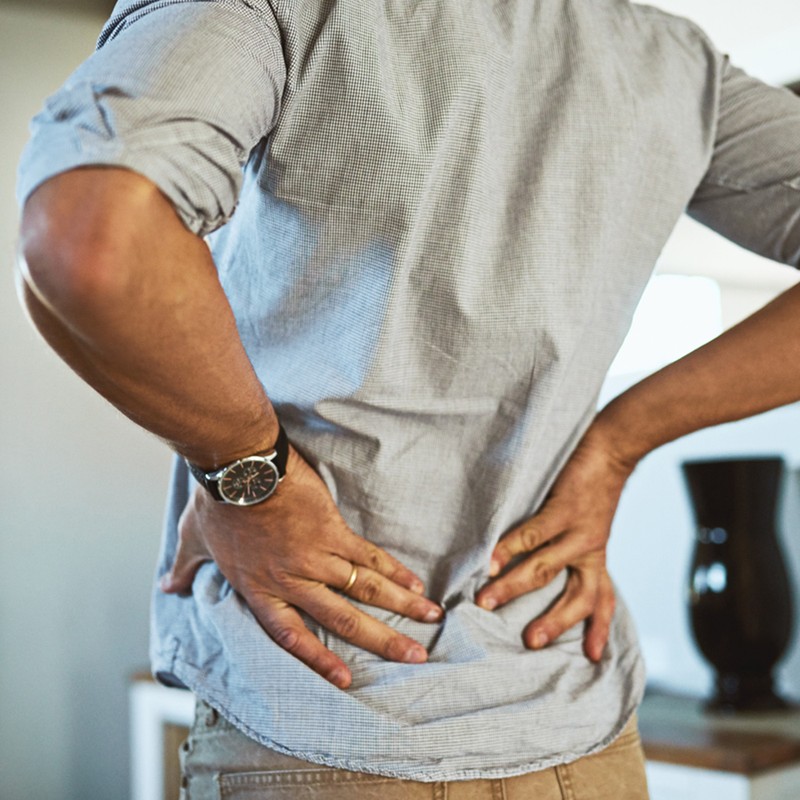9 Ways To Manage Back Pain
Understand The Damage
“Sitting at a desk all day causes an incredible amount of postural stress. In fact, studies show you put 90% more pressure on your back when sitting compared to standing. Sitting means your hip flexors are in a shortened position, preventing the glutes from firing, making them weak and thus overloading the hamstrings. Sitting also results in an anterior pelvic tilt, causing the abdominals to become underused and weaker. This knock-on effect is vital to remember as your back relies on these muscles. Standing up to take your calls and walking over to chat to your colleagues – instead of emailing – can make a real difference.” – Dr Brett Gibbens, sports chiropractor and stretch director at StretchLAB
Stay Active
“Being active is the only way to counteract the negative effects of a sedentary lifestyle and improve back health. Not regularly exercising can lead to a significant lack of core strength, hip, pelvic and spinal mobility, and possible degenerative changes that leave a person at a much higher risk of injury anywhere along their lower limb or trunk.” – Liam Rodgers, pilates clinician and consultant physiotherapist at Ten Health & Fitness
Think About Your Core
“Your core incorporates not just your stomach muscles and glutes but your entire torso, including your shoulders, back, chest, abs and glutes. Strengthening your entire core is vital for optimal back health. Try to incorporate core work into all your workouts, not just on abs days. For example, do an abs series in between other strength sets on arms and legs days. This will mean you’re engaging your core in the right way and giving it a bonus workout. In my opinion, this is how an athlete becomes a beast.” – Liam
Consider A Standing Desk
“A standing desk can reduce stress on the back as a whole, especially the lumbar spine. They can also improve core musculature, and strengthen the legs, feet and ankles, which will improve posture and balance. The average person can burn up to an extra 30,000 calories a year by standing at work as opposed to sitting – that’s the equivalent of running ten marathons. Think how that will help strengthen your back.” – Brett
Try Yoga
“Yoga, provided it is carefully guided, can be useful as a short-term fix for back pain, as it aids flexibility throughout the body. Several studies have proved this, including one specifically showing Iyengar yoga (known for its focus on precision and anatomical detail) may be effective for treating chronic spinal pain. However, if you are already very flexible or hypermobile, yoga should be avoided as it could exacerbate an existing condition.” – Brett
Carry On Lifting Weights
“It may seem counterintuitive, but strength and resistance training is one of the best steps you can take to improve back health. Our spines are designed to withstand strenuous lifting, including of weights. If you are a beginner, start with basic exercises such as squats and lunges, adding weights as you get stronger. Specific moves that can help with back strength include glute bridges, split squats, bird dogs, lat pulldowns and dead ants. Just remember that form is key.” – Brett
Maintain A Healthy Weight
“Being overweight puts you at increased risk of suffering with back pain. Obesity is commonly known as a risk factor for lower back pain specifically, but the main factor that can cause problems is increased abdominal tissue. This can pull your pelvis and spine into an anterior tilt, putting pressure on the small bones of your back. These bones aren’t designed to support our body weight, explaining why obesity can trigger back pain.” – Liam
Know It’s A Generational Thing
“Not only are younger generations leading increasingly sedentary lifestyles, but they’re spending more time on electronic devices, which can wreak havoc with the musculoskeletal system. The rise in popularity of HIIT training can also be problematic, with people sitting all day then running straight to the gym trying to PB a snatch.” – Liam
Invest In Your Mattress
“Lack of support from a mattress reinforces poor sleeping posture, strains muscles and throws the spine out of alignment, all of which contribute to back pain. If you wake up with back pain, but can stretch it out within 15 to 30 minutes, that’s a sure sign your mattress is doing more harm than good.” – Brett
Read the official NHS advice on back pain here.
To book a session at StretchLAB, visit Stretch-Lab.co.uk.
Services at Ten Health & Fitness include pilates, physiotherapy, massage, personal training and rehabilitation. Visit Ten.co.uk.
DISCLAIMER: We endeavour to always credit the correct original source of every image we use. If you think a credit may be incorrect, please contact us at [email protected].


